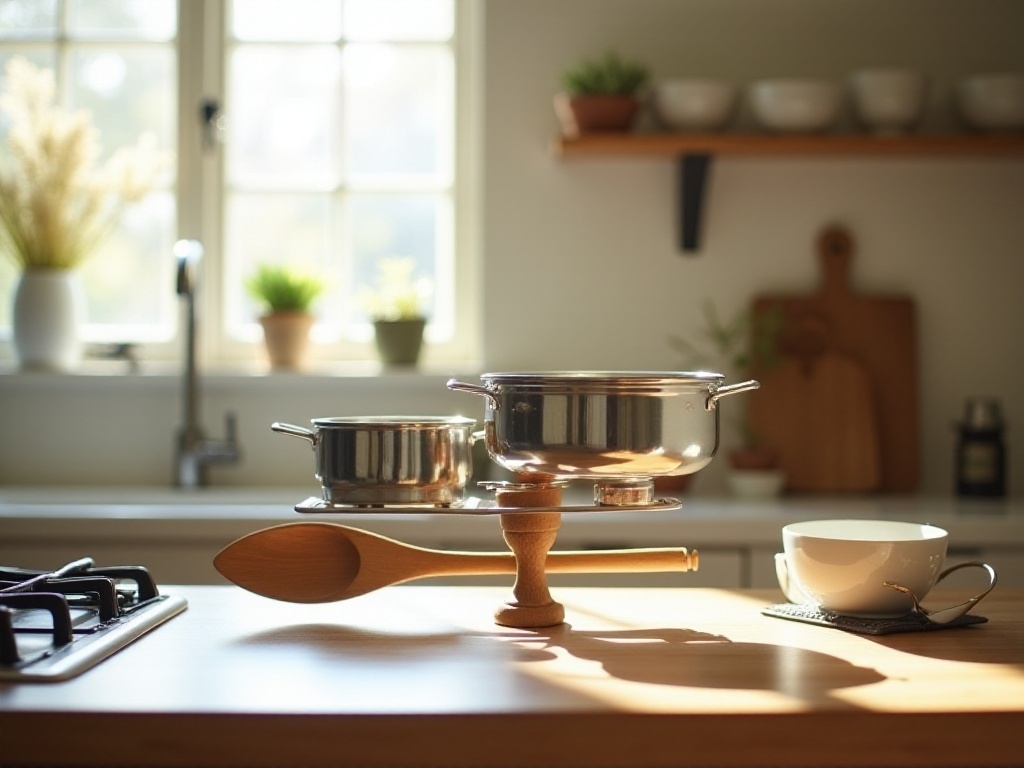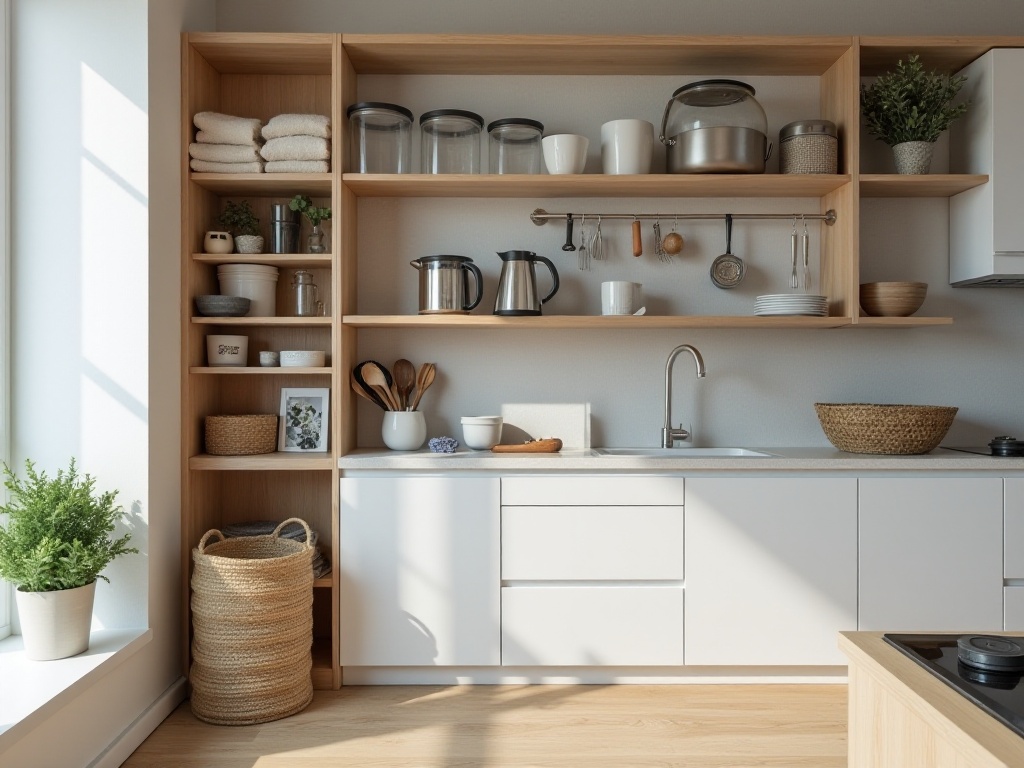Introduction
Do you ever feel like burying yourself in the couch when seeing your messy home? Don't worry! As a housewife who has been studying household tips for over a decade, I completely understand this feeling. Today, I want to share some tips that make cleaning super easy and fun. These techniques will definitely make your housework more efficient and your home beautiful!
When I first got married, housework gave me headaches, and I wanted to call cleaning services every day. But after years of exploration and experimentation, I discovered that cleaning can become really easy and even enjoyable once you master the right methods. The sense of achievement when seeing your refreshed home is simply amazing!
Kitchen Section
The kitchen is arguably the most challenging battlefield in our home, with oil and smoke splashing everywhere during cooking, and various sauce and seasoning stains driving us crazy. My kitchen was renovated just last year, and I was determined to maintain its beauty and prevent it from becoming greasy.
Speaking of kitchen cleaning, the range hood is the most headache-inducing. I used to worry a lot about cleaning it, trying various cleaners that were either ineffective or had harsh odors. Then one day, I had an inspiration and thought of white vinegar as a natural degreaser.
I mix white vinegar and warm water in a 1:1 ratio in a spray bottle and spray it on the greasy areas. I remember being worried about the effectiveness the first time, but after letting it sit for 10 minutes and wiping with a cloth, those stubborn oil stains came off easily! Since then, this has become my go-to method. Now I clean the range hood weekly using this method, keeping it effortlessly clean.
I must say, white vinegar is truly a kitchen cleaning marvel. It not only removes grease but also eliminates odors and kills bacteria. Best of all, vinegar is cheap and eco-friendly, so I don't feel guilty using it. I now use about 2-3 bottles of white vinegar monthly, which feels much more economical than buying specialized cleaners.
Sink cleaning is also crucial. I've noticed many people overlook daily sink maintenance, resulting in yellowing and odors. Actually, sink maintenance is very simple; the key is developing good habits.
My favorite is the lemon slice cleaning method. Every weekend, I put 3-4 lemon slices in the sink and rinse with hot water. The natural acidity of lemons removes limescale and eliminates odors. Most importantly, the lemon fragrance adds a natural freshness to the kitchen.
After three years of maintenance using this method, my sink still looks new. I've also found that sinks regularly cleaned with lemon rarely develop limescale. I used to have to remove limescale monthly, but now I barely need to worry about it.
Another recent trick I discovered is drying the sink with a towel after washing dishes. This effectively prevents limescale formation and bacterial growth. Though it adds an extra step, it's definitely worth it in the long run.
Cabinet maintenance is also important. My cabinets are natural wood and particularly susceptible to moisture. Later, I placed homemade dehumidifying bags in each cabinet, filled with a mixture of activated charcoal and baking soda. These bags not only absorb moisture but also eliminate odors, and since the ingredients are natural, there's no worry about harmful substances.
For kitchen floor tiles, I have a special formula. Mix white vinegar, lemon juice, and water in a 1:1:8 ratio. Mopping with this solution not only removes oil stains but also makes the tiles shine. Walking on floors cleaned with this method feels especially refreshing.

Living Room Section
The living room is our home's face and the place that most easily accumulates dust. Especially with fabric sofas and carpets, cleaning becomes even more challenging. But don't worry, I have some particularly effective methods.
Let's start with sofa cleaning. Last Chinese New Year, a bunch of relatives visited. The kids jumped around on the sofa and accidentally spilled juice on it. I almost panicked but calmed down immediately remembering my secret weapon.
I mix baking soda and water into a paste, about the consistency of pancake batter. Then gently apply it to the stains with a soft brush and wait for 15 minutes. During this process, you can see the baking soda absorbing the stains. After the surface dries, vacuum it up, and the stains will be removed along with the baking soda.
I've tried this method at many friends' homes with great results. Plus, baking soda is gentle and won't damage the fabric. I now do a deep clean of the sofa using this method monthly to keep it fresh and clean.
Carpet cleaning is also a skilled task. I've mixed a special carpet cleaning spray: white vinegar, warm water, and essential oil in a 2:8:1 ratio. When choosing essential oils, it's best to select fresh, natural scents like lavender or lemongrass to avoid overwhelming fragrance.
When using this spray, make sure to spray evenly without over-wetting. Then gently brush with a soft brush to let the cleaning solution penetrate the carpet fibers. After the carpet is completely dry, vacuum it, and the carpet will look like new.
I particularly love this method because it not only cleans the carpet but also adds a subtle fragrance to the home. Every time after using this method, walking into the living room feels especially pleasant. Plus, these materials are all natural, so there's no worry about effects on children or pets.
Living room glass cleaning also has its tricks. I put equal parts white vinegar and warm water in a spray bottle, adding a few drops of dish soap. This formula easily removes stains and fingerprints from glass without leaving water marks. When cleaning glass, I prefer using newspaper instead of cloth, which makes the glass especially bright.
For wooden furniture like TV stands and coffee tables, I have a special formula. Mix olive oil and lemon juice in a 1:1 ratio, apply a small amount with a soft cloth, and gently wipe the furniture surface. This not only removes dust but also moisturizes wooden furniture, maintaining its shine.
As for light fixture cleaning, I've noticed many people tend to overlook it. Actually, dust on light fixtures seriously affects lighting quality. I regularly use a feather duster to gently remove dust from lampshades, then wipe with a slightly damp cloth. This maintains clean light fixtures and keeps the room brighter.

Bathroom Section
Bathroom cleaning really tests one's patience and skill. Many people find bathrooms particularly difficult to maintain, but it's not hard at all once you master the right methods.
Shower glass limescale is really annoying. I've tried various descaling agents on the market with mediocre results and harsh smells. Later I discovered that rubbing lemon slices dipped in table salt directly on the glass works surprisingly well.
The key to this method lies in the natural acidity of lemons and the abrasive action of salt. After each cleaning, I dry the glass with a towel to prevent limescale from forming again. Now my shower glass maintains its clarity, which looks especially nice.
Toilet cleaning is also important. My method is: first sprinkle baking soda into the toilet, then pour in white vinegar. You'll see them start to foam, which is the chemical reaction happening. Wait 30 minutes before flushing, and the limescale and odors will disappear together.
What makes this method better than regular toilet cleaners? First, it's completely non-toxic and won't produce irritating odors. Second, the combination of baking soda and white vinegar not only cleans the surface but also clears the drain pipes, achieving two purposes at once.
Bathtub cleaning also has its techniques. I rinse the tub with warm vinegar water, then sprinkle baking soda and gently scrub with a soft brush. This not only removes limescale but also keeps the tub shiny. After cleaning, remember to rinse thoroughly with clean water and dry with a towel.
Bathroom floor and wall tiles also need regular deep cleaning. I make a cleaning paste with white vinegar, baking soda, and warm water, applying it to tile surfaces and grout lines. After waiting 15 minutes, gently scrub with a brush, then rinse with clean water. This effectively removes dirt and mold from tile surfaces.
Maintaining towel racks and other metal fixtures is also important. I wipe these metal surfaces with olive oil, which not only prevents rust but also maintains shine. After wiping, just remove excess oil with a dry cloth.

Storage and Organization
After discussing cleaning, let's talk about storage. Many people feel their homes are always messy, but the key is finding suitable storage methods.
I highly recommend the "sandwich storage method." Like making a sandwich, divide items into three layers: frequently used items on top, occasionally used items in the middle, and rarely used items at the bottom. This makes items easy to find and prevents rarely used items from occupying the most convenient spots.
For example, in closet organization, I put daily wear clothes in the most accessible positions, seasonal clothes in the middle layer, and rarely worn formal wear or special occasion clothes at the bottom or back. This makes getting dressed daily very convenient without making the closet messy.
I also particularly like using the vertical folding method for clothes storage. This method involves folding clothes into rectangles and storing them vertically in drawers or storage boxes. This not only saves space but also allows you to see all your clothes at once, eliminating the frustration of not finding the clothes you want to wear.
Drawer organization is also important. I use small boxes or organizers to divide drawers into different sections, preventing small items from becoming jumbled. I've found that when everything has its fixed place, there's more motivation to keep things organized.
Bookshelf organization also has its principles. I like to arrange books by frequency of use and theme. Frequently read books are placed at eye level, while less frequently read ones can go on upper or lower shelves. Meanwhile, I leave some space on the shelves for small decorative items, making it both practical and aesthetic.
Kitchen item storage has many techniques. I categorize seasonings by frequency of use, placing frequently used ones near the stove and less used ones in higher cabinets. Knives and utensils are also organized by frequency of use, making cooking very convenient.

Final Words
Through years of exploration and practice, I've deeply realized that creating a clean and comfortable home isn't difficult; the key is using the right methods and developing good habits. Everyone can find their most suitable cleaning and storage methods; what's important is persistence.
Every corner of life hides little tricks to make days better. I hope these experiences I've shared can help everyone. Next time we'll continue sharing more practical household tips to make our homes even more warm and beautiful.
Remember, a clean home not only makes us feel happy but also brings more happiness to our family. Let's work together to create a clean and comfortable living environment!


